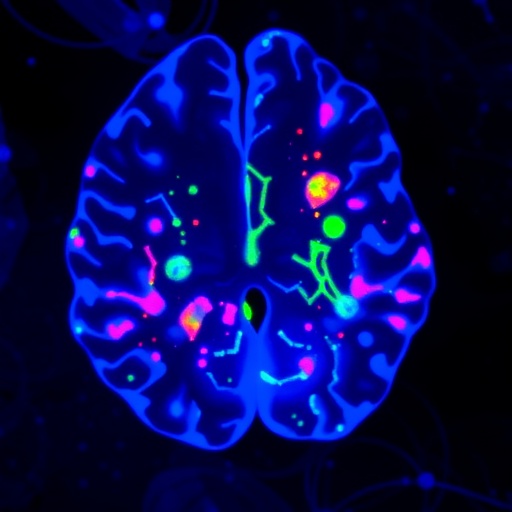In a groundbreaking study that pushes the boundaries of neuroscience and psychiatric genetics, researchers have unveiled how the disrupted tempo of cortical neuron development may underlie the complex manifestation of schizophrenia associated with the 22q11.2 deletion syndrome. Using cutting-edge brain organoid technologies, the team reconstructed miniature, three-dimensional brains derived from patient cells, providing unprecedented insights into the cellular and molecular mechanisms of this enigmatic neurodevelopmental disorder. These findings illuminate the intricate interplay between genetics and brain maturation, offering new paths for therapeutic interventions and biomarker discovery.
The 22q11.2 deletion syndrome, often described as a “chromosomal crossroads,” is caused by the deletion of a small section on the long arm of chromosome 22, which profoundly increases the risk for neuropsychiatric conditions including schizophrenia. Despite well-established clinical correlations, the precise neurobiological substrates that link this genetic deletion to schizophrenia have remained elusive. The latest study addresses this knowledge gap by leveraging patient-derived induced pluripotent stem cells (iPSCs) to grow brain organoids—a method that mimics early brain development outside the human body—allowing direct observation of neuronal progressions impacted by the deletion.
.adsslot_CPTEOlXGbq{ width:728px !important; height:90px !important; }
@media (max-width:1199px) { .adsslot_CPTEOlXGbq{ width:468px !important; height:60px !important; } }
@media (max-width:767px) { .adsslot_CPTEOlXGbq{ width:320px !important; height:50px !important; } }
ADVERTISEMENT
Technically, the researchers employed single-cell RNA sequencing coupled with sophisticated time-lapse imaging to dissect the developmental trajectories at a granular level. These tools allowed them to pinpoint disruptions in the balance between proliferating neural progenitors and postmitotic neurons, unveiling a delay in cortical neuron differentiation. Such delayed maturation could translate to faulty cortical circuitry formation, which underpins cognitive deficits and psychosis phenotypes observed clinically. These cellular phenotypes provide a mechanistic link connecting chromosomal aberrations to altered brain function in schizophrenia.
Equally fascinating was the observation of altered excitatory-inhibitory neuron ratios in patient-derived organoids. Neuronal excitatory-inhibitory balance is crucial for information processing and network synchronization in the cortex. Imbalances have long been hypothesized in schizophrenia etiologies. This study provides concrete biological evidence that the 22q11.2 deletion disrupts this balance by skewing neurogenesis, which could contribute to the aberrant neural oscillations and cognitive disturbances characteristic of the disorder.
Crucially, the organoid platform enabled longitudinal studies simulating prenatal-to-postnatal cortical development stages. This temporal aspect unraveled that the aberrant pace is not merely a transient developmental delay but a sustained dysregulation, which might perpetuate altered brain circuit maturation into adolescence and adulthood. This chronic disturbance offers a plausible explanation for the typical onset of schizophrenia symptoms during late adolescence or early adulthood, linking early developmental defects to delayed clinical manifestation.
From a translational perspective, the study’s findings carry substantial implications. The ability to model patient-specific neurodevelopmental trajectories in vitro paves the way for personalized medicine approaches. Drug screening assays can now incorporate patient-derived organoids to test compounds that might rescue or mitigate the aberrant neurodevelopmental pace. Additionally, molecular markers identified in the organoids could be developed into biomarkers for early diagnosis, potentially shifting the clinical paradigm toward preventative interventions.
The methodology adopted in this work highlights the transformative power of brain organoid technology in psychiatric genetics. Traditional models have struggled to capture the human-specific facets of schizophrenia pathophysiology. By integrating multi-omics analyses with precise developmental staging in an organoid system, researchers have forged a powerful platform that elucidates complex genotype-phenotype relationships. This approach is emblematic of a new era in neuropsychiatric research, where reductionist models give way to organoid-based systems capable of recapitulating human brain complexity.
Moreover, the study’s interdisciplinary nature underscores the importance of collaboration across stem cell biology, genomics, neurodevelopment, and clinical psychiatry. The seamless integration of advanced cellular models with high-resolution single-cell transcriptomics and longitudinal imaging techniques exemplifies the convergence of technology and biology. This synergy enables a holistic understanding of how chromosomal deletions ripple across scales, from gene expression disruptions to circuit dysfunctions, ultimately manifesting as psychiatric illness.
The research also contributes to a growing body of evidence emphasizing the significance of developmental timing in neuropsychiatric disorders. It suggests that therapeutic windows might exist during specific maturational phases when interventions could correct or compensate for aberrant neuronal pacing. This temporal insight challenges static views of schizophrenia as a fixed neurodegeneration and reinforces the concept of it being a dynamic neurodevelopmental disorder amenable to intervention.
Ethical considerations surrounding brain organoid research have garnered attention, especially as these models increase in complexity and approach functional relevance. This study exemplifies responsible research by focusing on mechanistic understanding and therapeutic potential without suggesting sentient properties of the organoids. It highlights the importance of maintaining strict ethical frameworks while harnessing the promise of organoid systems to resolve long-standing psychiatric mysteries.
Looking forward, this landmark investigation opens numerous avenues for future research. It sets the stage for exploring how environmental factors, such as prenatal stress or immune activation, might interact with the 22q11.2 deletion to further modulate cortical neuron development. Additionally, the role of non-neuronal cells like astrocytes and microglia within organoids presents a frontier for understanding glial contributions to schizophrenia pathogenesis. The refinement of organoid models to include vascularization and longer culture periods could yield even deeper insights into the chronic evolution of neuropsychiatric disorders.
In conclusion, the aberrant pace of cortical neuron development identified in brain organoids derived from 22q11.2 deletion syndrome patients marks a significant leap in deciphering the cellular etiology of schizophrenia. By bridging genetics, cell biology, and psychiatry, this study showcases how advanced modeling technologies reveal hidden aspects of human brain development and disease. It heralds a future where targeted interventions might be designed to recalibrate developmental trajectories, offering hope for individuals affected by schizophrenia and related disorders.
Subject of Research: Cortical neuron development abnormalities in brain organoids derived from patients with 22q11.2 deletion syndrome-associated schizophrenia.
Article Title: Aberrant pace of cortical neuron development in brain organoids from patients with 22q11.2 deletion syndrome-associated schizophrenia.
Article References:
Rao, S.B., Sun, Z., Brundu, F. et al. Aberrant pace of cortical neuron development in brain organoids from patients with 22q11.2 deletion syndrome-associated schizophrenia. Nat Commun 16, 6986 (2025). https://doi.org/10.1038/s41467-025-62187-x
Image Credits: AI Generated
Tags: 22q11.2 deletion syndromebiomarker discovery in neurodevelopmental disordersbrain organoid technologycellular mechanisms of neuropsychiatric conditionscortical neuron growthgenetic factors in brain maturationinduced pluripotent stem cellsneurobiological substrates of schizophreniapsychiatric genetics researchschizophrenia neurodevelopmenttherapeutic interventions for schizophreniathree-dimensional brain models





